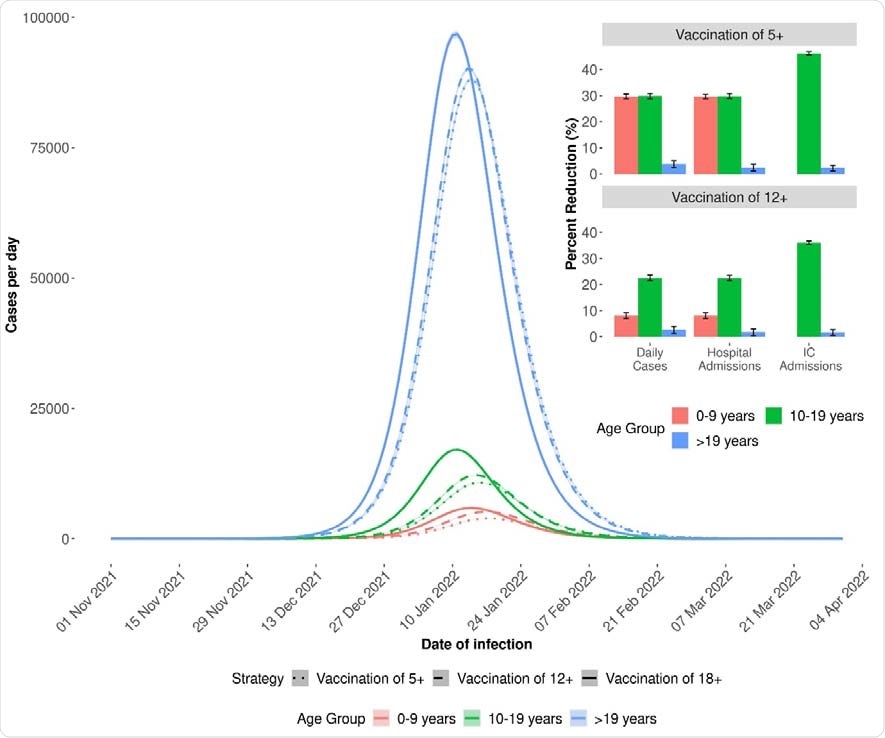A recent study by researchers from the Netherlands highlights that introducing vaccination programs against coronavirus disease 2019 (COVID-19) to adolescents and children may reduce infection rates and severe disease outcomes – both in these age groups and in the population a whole. The paper is currently available on the medRxiv* preprint server while it undergoes peer review.
Healthy adolescents can get infected with the severe acute respiratory syndrome coronavirus 2 (SARS‐CoV‐2) and subsequently transmit the virus, although there is a very low risk that they will experience severe disease and death when compared to the adults. However, there is a possibility that they may develop long COVID, which means their symptoms may persist for months.
And while a new wave of COVID-19 is spreading around many countries, threatening to overwhelm our healthcare systems, there is an ongoing debate whether to vaccinate adolescents (i.e., those aged between 12 and 17 years of age) and even children older than 5 years of age.
But even though vaccinating adolescents and children may curb the transmission from these groups to other more high-risk and vulnerable populations, there is a worry of potential adverse events from vaccination that may outweigh such limited risk of severe disease.
In order to quantify the benefits of extending COVID-19 vaccination beyond adults, a research group led by Dr. Kylie E. C. Ainslie from the National Institute for Public Health and the Environment in Bilthoven (the Netherlands) decided to compare daily case burden, hospital admissions, and intensive care needs under different vaccinations scenarios.
Simulating disease outcomes
For that purpose, these scientists have developed a very stringent age-structured susceptible-exposed-infectious-recovered (SEIR) model to precisely simulate the aforementioned disease outcomes. The model was designed to include a single vaccine product with a two-dose regimen.
Furthermore, the model has been divided into 10-year age bands, accounting for dissimilarities in susceptibility and infectiousness by age group, seasonality in transmission patterns, modalities of vaccine protection (such as infection and/or transmission), and vaccine characteristics (most notably vaccine effectiveness).
Sensitivity analyses were also performed in order to appraise the exact impact of extending vaccination to adolescents in the presence of waning vaccine-induced immunity (even though the researchers did not assume waning of immunity from natural infection).

Daily cases for each vaccination scenario (5+, 12+, 18+) by age group (main) and percent reductions in disease outcomes in 5+ and 12+ vaccination scenarios compared to 18+ scenario (inset). Simulations were run from 22 June 2021 until 31 March 2022 with constant vaccine effectiveness. Control measures are relaxed on 1 November 2021.
The advantages of broader vaccination coverage
One of the main findings of this study was that, upon lifting of all non-pharmaceutical control measures, a large infection wave is deemed to occur despite any type of vaccination strategy pursued. However, different vaccinations scenarios (which included adolescents and children) revealed notable differences.
More specifically, the researchers found a 5.7% reduction of overall case burden, a 2% reduction of hospital admissions, as well as a 1.7% reduction of intensive care admissions when those 12 years and above were vaccinated in comparison to the scenario when only adults have been vaccinated.
And when those 5 years and above were vaccinated, the researchers have described an 8.7% reduction of overall case burden, a 3.2% reduction of hospital admissions, and a 2.4% reduction of intensive care admissions when compared to the scenario of adult-only vaccination.

Daily cases by vaccination scenario and age group in the absence (faded lines) and presence of waning vaccine-induced immunity. Simulations were run from 22 June 2021 until 31 March 2022. Control measures are relaxed on 1 November 2021.
Potential implications
In a nutshell, these results underscore the important benefits of extending COVID-19 vaccination plans to children and adolescents to reduce infection burden and severe COVID-19 outcomes in children/adolescents and the population as a whole.
“While the results presented here are based on population characteristics and the COVID-19 vaccination program in the Netherlands, they may provide valuable insights for other countries who have not yet extended vaccination beyond adults”, say study authors in this medRxiv paper.
Likewise, a reduction of infections in these age groups (together with supplementary control measures) may well be an evidence-based and realistic strategy to avoid the need for school closures in the event of a new wave of SARS-CoV-2 infections.

 This news article was a review of a preliminary scientific report that had not undergone peer-review at the time of publication. Since its initial publication, the scientific report has now been peer reviewed and accepted for publication in a Scientific Journal. Links to the preliminary and peer-reviewed reports are available in the Sources section at the bottom of this article. View Sources
This news article was a review of a preliminary scientific report that had not undergone peer-review at the time of publication. Since its initial publication, the scientific report has now been peer reviewed and accepted for publication in a Scientific Journal. Links to the preliminary and peer-reviewed reports are available in the Sources section at the bottom of this article. View Sources
Journal references:
- Preliminary scientific report.
Ainslie, K.E.C. et al. (2021). The impact of vaccinating adolescents and children on COVID-19 disease outcomes. medRxiv. https://doi.org/10.1101/2021.10.21.21265318, https://www.medrxiv.org/content/10.1101/2021.10.21.21265318v1
- Peer reviewed and published scientific report.
Ainslie, Kylie E C, Jantien A Backer, Pieter T de Boer, Albert Jan van Hoek, Don Klinkenberg, Hester Korthals Altes, Ka Yin Leung, Hester de Melker, Fuminari Miura, and Jacco Wallinga. 2022. “A Scenario Modelling Analysis to Anticipate the Impact of COVID-19 Vaccination in Adolescents and Children on Disease Outcomes in the Netherlands, Summer 2021.” Eurosurveillance 27 (44). https://doi.org/10.2807/1560-7917.es.2022.27.44.2101090. https://www.eurosurveillance.org/content/10.2807/1560-7917.ES.2022.27.44.2101090.